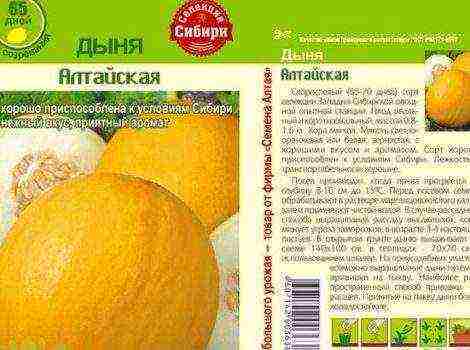Content
Growing and keeping broilers in cages at home has its advantages and disadvantages, and this is due to the fulfillment of a number of requirements in order to preserve the livestock and ensure its growth and development.

Keeping broilers in cages at home
Features of broilers for breeding
The cage content of broilers in a household is related to their characteristics, since, in contrast to the breeding rate of conventional chicken breeds, the main task in growing broiler lines is to gain weight as quickly as possible.
Of no small importance when deciding whether to grow them in a confined space is that these hybrid breed lines are capable of intensively gaining body weight, for which they were bred in order to get more chicken meat in a short time period.
Besides the fact that broilers are a source of meat products, many broiler breeds have established themselves as good producers of young stock, demonstrating high egg production rates.
Among the distinctive features of broiler poultry that require a special approach to keeping:
- large size and large (on average about 5 kg) weight of birds, which limits the number of individuals for one cage,
- intensive increase in body weight,
- obesity of the trunk, located horizontally.
Selection of broiler chicks
To select young animals for the purpose of keeping them in cages, the decision is made depending on the purpose of breeding: for meat or for obtaining eggs. Particular attention should be paid not only to the quality of the breed, but also to the behavior of the selected chickens, their activity, reaction to noise, the condition of the eyes and plumage.
It is possible to buy healthy broilers, which would subsequently provide a good economically beneficial result, only at a poultry farm or from professional poultry houses who are responsible for observing all standards for breeding and raising chicks.
Due to the fact that mortality rates among newborn chickens are high, poultry houses recommend purchasing young animals that are at least 10 days old and have a standard size.
You can grow and keep broilers in cages at home using one of 2 available methods:
- extensive, when chickens are purchased in the spring and raised until mid-summer, after which they are slaughtered and sold, the re-recruitment of chickens is not performed until the next season,
- intensive, in which a new generation is acquired every quarter, and individuals that have reached 2.5 months of age go to slaughter.
The most optimal age for slaughter of broiler breeds is 70 days. After this period, the birds begin to suspend their growth and gain in weight, and the amount of feed consumed increases. Such keeping of broilers becomes economically unreasonable.
Advantages and disadvantages of cell cultivation
Raising and keeping broiler chickens in cages is considered to be a more economical method than floor standing. The cell method has become more popular with the advent of modern technologies that allow you to organize your own cell batteries. Among the benefits of breeding broilers in cages, poultry houses note:
- saving space in the room and reducing the associated costs of electricity, heating and ventilation,
- reducing the amount of required feed as a result of being in a limited area,
- an increase in the growth rate due to a decrease in bird activity,
- limiting contact and, as a result, preventing the spread of various infectious and other diseases,
- the absence of contact of birds with the litter and the inability for birds to eat excrement,
- optimized possibilities of feeding and watering birds, caring for them, veterinary examination, thinning the number of individuals.
In addition, reviews of poultry houses who prefer to grow and keep broiler breeds of chickens in cages note a reduction in the period for feeding chickens by an average of 3-5 days.
The disadvantages of keeping broilers, many include:
- rather large initial financial and labor costs for arranging cages or purchasing ready-made equipped complexes,
- obligatory daily cleaning of the cages, disinfection measures after the cage is free of the bird.
In addition, the cellular content of domestic broilers has an impact on their health. So, birds grown in a cage begin to suffer from problems with paws due to limited activity and a sharp large gain in weight. Affects the condition of chicken legs and the mesh floor of the cage.
We create conditions for cell cultivation
Before deciding on cages and keeping broilers at home, you need to decide on the main issues regarding the conditions for breeding birds in a confined space.
Premises and equipment
For self-erection of structures or the installation of ready-made sets of equipment for planting chickens, an ordinary wooden shed can be chosen as a suitable room. In the summer, chicken cages are placed directly on the street.
The list of equipment required for the purchase includes:
- lamps for light illumination,
- heating elements to create heat,
- ventilation systems,
- feeders and drinkers.
Microclimate
For forcing broiler chicks indoors, the necessary conditions must be created and maintained:
- the temperature for day-old chicks is about 32 ° С with a gradual decrease by 0.2 indicators daily until reaching 16-18 ° С by one week of age,
- humidity from 50 to 70%,
- daylight hours - at least 23 hours for chickens, reduced from one week of age to 16-20 hours.
Food
When breeding chickens by the cage method, it is recommended to ensure the constant presence of feed in the cages. The diet of small broilers includes boiled eggs, wheat grains, greens. Starting from five days of age, chickens are soldered with vitamin solutions, adding shell rock and bone meal to the diet. In the last weeks of growth until the moment of slaughter, the chicken feed is diversified with roughage.
Growing broilers in cages at home DIY broiler cages - zolotyeruki
Growing broilers in cages at home, part 1
DIY broiler cages
Bird cage requirements
Today, for the cultivation of meat broilers on an industrial scale and in household conditions, cell batteries are created to ensure compliance with the stocking density of chickens. They are mounted in a tier of 4-6 cell rows and allow keeping up to 150,000 individuals in a poultry house. You can see how it looks in the video. The block system is equipped with the possibility of feeding and watering birds, and allows you to install additional light sources, if necessary. The floor of these cages is extended, which allows the house to easily catch the bird. A special tape is placed under the floor to remove droppings.
Modern technologies make it possible to automate such keeping of chickens using built-in heating and ventilation systems, controlled both in manual and automatic modes.
For home keeping of chickens in a small backyard farm, lightweight versions of cage batteries of 2-3 tiers are possible, no more, subject to the planting density, which can be made with your own hands if you follow the video instructions.
Among the basic requirements for self-assembled cage content are:
- norms of maximum stocking density - up to 25 chicken heads per 1 sq. m of floor, but not more than 40 kg of mass by the final stage of cultivation,
- section material - galvanized mesh, wooden cages are less wear-resistant,
- the presence of grooves outside sections for manual feeding and feeders inside for mechanized,
- the presence of files and a drinking water supply system,
- availability of galvanized pallets for droppings,
- a small cell at the mesh covering the floor.
The presence of wheels in the equipment of the cage batteries creates advantages for the movement of the cages when the heat enters the street.
Similar articles
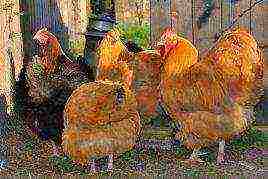
Reviews and comments
 Novice poultry farmers are wondering which is better - growing broilers in cages or in a special enclosure. To make an informed decision, you need to have complete information about the correctness of keeping chickens. Broilers are bred for the sake of gain in a short time, accordingly it is important to create favorable conditions for the chickens so that they develop correctly.
Novice poultry farmers are wondering which is better - growing broilers in cages or in a special enclosure. To make an informed decision, you need to have complete information about the correctness of keeping chickens. Broilers are bred for the sake of gain in a short time, accordingly it is important to create favorable conditions for the chickens so that they develop correctly.
Pros and cons
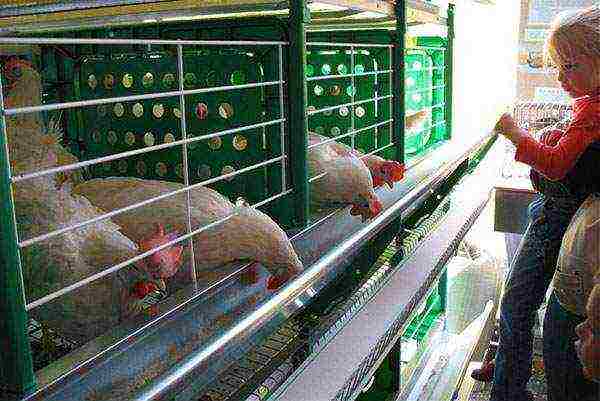 The cage keeping of broilers is considered more economical, in comparison with the floor. But it, along with its merits, has its drawbacks.
The cage keeping of broilers is considered more economical, in comparison with the floor. But it, along with its merits, has its drawbacks.
The pluses include a number of criteria:
- Saves space. This means that energy costs will also be reduced as the chicks need light, heating and ventilation.
- The consumption of feed is significantly reduced. This is due to the fact that the chickens do not scatter feed and do not trample on it.
- Due to the limited movement, the mass gain occurs faster, since the energy is spent on growth, and not on movement.
- When broilers are raised in cages, they have less contact with other individuals. This communication is limited to neighbors in the cage, which allows you to take timely measures when the infection spreads.
- Easier daily cleaning. It also helps to reduce the risk of spreading infection, plus the chick does not peck at its droppings or breathe ammonia.
- Bird care is more streamlined. This includes not only drinking and feeding, but also a veterinary examination, which must be carried out daily.
For large-scale production, a big plus will be precisely a faster weight gain, which will significantly increase profits, since fattening will be less by a week in comparison with floor keeping.
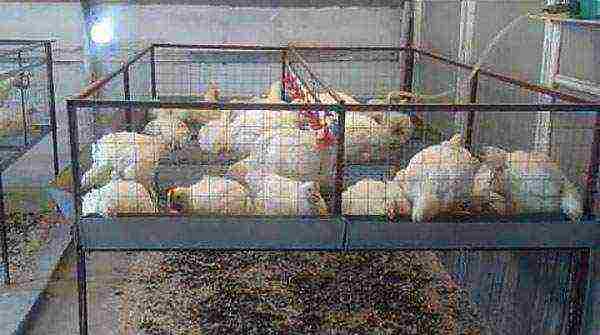 The disadvantages include indicators such as:
The disadvantages include indicators such as:
- high costs for equipment and cages;
- creating a special climate in a room with birds - light, temperature, ventilation;
- you will have to purchase special compound feed for a balanced chicken nutrition;
- the occurrence of problems with the legs when reaching a large weight, occurring due to being on a mesh floor;
- daily cleaning of litter trays is mandatory;
- taste indicators are lower than that of free-range chickens.
After freeing the cage from the chickens, disinfect it to exclude possible contamination of the next batch of broilers.
Private house cages
 In order for the maintenance of broilers in cages at home to be correct, you need to prepare in advance. First of all, choose a room, purchase the necessary equipment and purchase cages. You can build them yourself or buy a ready-made industrial version. Any room can be used, for example, a barn. In summer, cage rearing is possible outdoors.
In order for the maintenance of broilers in cages at home to be correct, you need to prepare in advance. First of all, choose a room, purchase the necessary equipment and purchase cages. You can build them yourself or buy a ready-made industrial version. Any room can be used, for example, a barn. In summer, cage rearing is possible outdoors.
You need to remember about the temperature regime. Overheating will adversely affect bird health.
The equipment includes:
- lamps for lighting, since chickens need high-quality constant light for proper development;
- special heating elements, since chickens need a high air temperature - starting from 36 degrees, which gradually decreases to 18 degrees as they grow up;
- ventilation mechanisms necessary for the comfortable and healthy development of poultry.
- feeders and drinkers.
Growing broilers at home in cages means purchasing or making a cage on your own. You can buy it by choosing from a variety of factory-made models. In this option, it remains only to choose the size and equipment of the cage. Many manufacturers sell cages with already built-in feed and water feeding mechanisms, as well as automatic cleaning of the litter tray.
To make a cage with your own hands, it is advisable to first familiarize yourself with the video of broilers in cages at home. There are different cell options. It will be easier to navigate the views - what materials are easier to make and more convenient to use.
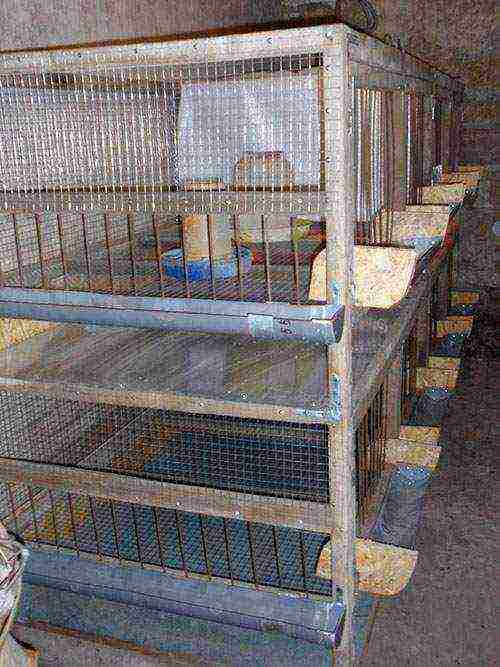 To begin with, a frame is built. It can be made both from a bar and from a metal profile. Further, a grating for the walls and floor is attached to it. Walls can also be made of plywood, but the ventilation will be much better when the grille is installed. The bottom of the cages needs a fine mesh cage to avoid injury to the chicks. Some manufacturers install plastic pallets together with nets. Galvanized sheets are prepared and installed under the cage floor. It is advisable to make them removable for the convenience of handling and cleaning the droppings.
To begin with, a frame is built. It can be made both from a bar and from a metal profile. Further, a grating for the walls and floor is attached to it. Walls can also be made of plywood, but the ventilation will be much better when the grille is installed. The bottom of the cages needs a fine mesh cage to avoid injury to the chicks. Some manufacturers install plastic pallets together with nets. Galvanized sheets are prepared and installed under the cage floor. It is advisable to make them removable for the convenience of handling and cleaning the droppings.
Content standards
 When broilers are grown in cages, you need to adhere to zootechnical standards:
When broilers are grown in cages, you need to adhere to zootechnical standards:
- On average, 1 sq. m. should have an average of 23 heads, while the weight at the finish line should not exceed 40 kg.
- With groove feeding, it is necessary to allocate about 2.5 cm for 1 chicken. When feeding from a round container, there should be, on average, 50 individuals.
- With a vacuum drinker, which is produced in the early days, a ratio of 50 chicks to 1 drinker must be observed. Further, with the grooved version, it is enough to allocate 2 cm per head.
- Compliance with temperature standards. When the chicks are still small, the temperature is maintained at about 36 degrees. After, decrease by 0.2 degrees daily. Thus, at week 7, the temperature should reach 17-18 degrees. With her, in the future, and contain adults.
- You need to pay attention to humidity. It should be around 60%. The well-being of the bird, its respiratory system and the feeling of temperature depend on the correct setting of humidity.
- It is important to follow the light regime. If for small chickens almost round-the-clock lighting is needed, that is, 23 hours a day should be illuminated with high-quality light. As you grow older, on day 7, you need to switch to day / night mode. The light period will be about 17-19 hours.
It will take about 70 days to grow broilers at home in cages. After that, the chicken begins to gain weight more slowly and consume more feed. Accordingly, it makes no sense to grow it further. But even at this age, the weight of the broiler will be about 2.5 kg.
Broilers from chick to slaughter in cages - video
.
There is a wide variety of breeds of meat chickens on the market, both from our breeding farms and abroad. The most popular is the Smena-7 breed, bred by the Smena enterprise and meeting all world standards in the field of growing livestock products for slaughter. Among good domestic breeds, Adler silver, Kuchin anniversary, Rodailanp are distinguished, but these are crossbreeds and the amount of meat output from them is less.

Broiler "Smena-7"
Western broilers that are popular with our breeders include Cobb 500 and ROSS - 308. The main feature of this young is an enlarged tummy and a bluish color of legs and beak.
Chick selection
The choice of chickens for growing at home should be approached responsibly. Many people prefer to take day-old chicks, so that later they can be sure that their pets are vaccinated against various diseases and have passed all the necessary research. But it should be borne in mind that the breeding of small chicks implies a rather high mortality rate, therefore it should be taken from trusted producers.
It is most reasonable to take young animals about ten days old, among which mortality will be lower, and there is no need to spend money on vaccinations and sanitization.
Some breeders, in order to prevent various diseases during growing, prefer to buy broiler chickens, and then, having received hatching eggs from them, raise the chicks on their own, with their own hands.
When buying chicks, pay attention to their condition and appearance. They should be active, respond well to noise and sounds, with shiny eyes and a soft belly, butt and body fluff - clean.
If the chicken is lethargic, apathetic, with a dull look, then this clearly indicates the presence of some kind of disease.
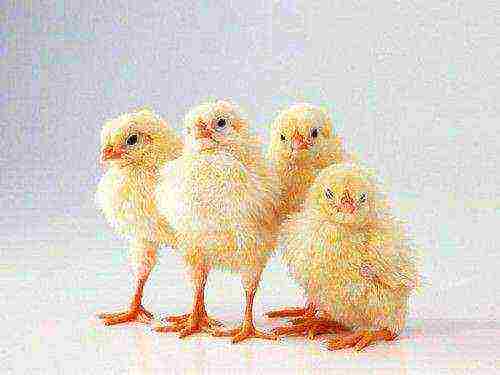
Broiler chickens
The main rules for growing broilers at home
There are a number of important points when breeding young stock, the observance of which is simply necessary if you want to get an excellent healthy livestock with a normal weight.
Feeding
Birds are fed a lot and ad libitum, they do not eat when they sleep. It is necessary to constantly monitor that there is food and water. Broilers drink warm water; cold water can cause them to catch colds and get sick. In the first days of life, chickens should be given a mash of chopped boiled eggs in milk or warm boiled water and herbal food, where there are many vitamins.
As the birds grow, the frequency of feeding per day can be reduced, and more compound feed, cereals, food waste (necessarily cooked) can be introduced into the diet, and the amount of protein can be gradually reduced, otherwise it may not be transformed into meat, but fat. How well the bird is eating can be checked by feeling its goiter with your own hands, if it is too hard, then you need to water more, if it is soft, add food. It is necessary to take into account the fact of mortality of two or four birds - this is the norm, large losses indicate improper care.
The readiness of the bird for slaughter can be checked under the wings and in the chest, where, if you inflate the feathers, the bumps of fat should be visible.

Cereals are the basis of broiler diets
Heat and lighting
Chicks of this breed need warmth, otherwise they will get sick and be lethargic. When chicks have just hatched, the temperature in the place where they are kept is kept at 30 ° C, as the birds grow, the heat level can be slightly reduced to 25 ° C, and adult broilers are kept at 20 ° C.
The level of illumination is important, where the young are kept, which should be made so that it can be adjusted with your own hands. Some need to be shaded, and some should be left illuminated, if the chickens want to, they will come out into the light, and when they need to take a nap, they will go to a dark corner.
Do not use fluorescent lamps when growing at home, they flicker imperceptibly to our eyes, and pets will be underweight.
Good bedding
Broilers should be kept on a clean and dry bed, so as not to chill and frostbite feet, as it can be used ordinary paper, hay or sawdust. Change as it gets dirty.

Broilers need quality bedding
Compliance with sanitary standards
It is imperative to wash the cages, change trays with droppings, keep drinkers and feeders clean. Do not leave yesterday's mash in the feeders, the shelf life of which is only three hours, it turns sour and turns into a continuous content of pathogens. Young animals, and especially very small chickens, suffer from this, broilers become lethargic, they have liquid droppings.
Cell selection
Many breeders believe that broilers should be caged as they gain weight better and consume less feed. Free-range chicks gain weight more slowly and have a stiffer meat than cage broilers.
In which cages is it better to breed poultry at home? The best option would be a design invented by Russian breeders. It is a kind of small multi-storey house that you can make with your own hands, where the newly hatched chicks are kept on the top floor, and as they go down, the young and adult broilers are kept. In front of the usual pens and cages, its advantages are that:
- allows you to easily vary the levels of heat and light;
- portable (make wheels and move easily);
- does not require a lot of space;
- can be easily done by hand.

Cage drawing: 1) feed dispenser, 2) egg collector, 3) frame, 4) cage, 5) feeder, 6) drinker, 7) scraper
Availability of a pet kit
When raising broilers at home, take care of their vaccination, monitor their health, for which it is necessary to have a special first-aid kit, which should contain the most necessary preparations for chickens.
Growing stages
Do-it-yourself feeding at various stages of rearing young stock should be especially noted:
- chickens - 1-5 days;
- young animals - 5-30 days;
- full-fledged broilers - after 30 days.
As soon as the chicks hatch and dry out a little, you need to start the first feeding. Chickens willingly peck boiled eggs, oatmeal, finely crushed grain mixed with milk or warm boiled water. Their digestive tract is weak and not ready for rough food. The chicks should be kept warm, dry and with sufficient light.
The ration of grown young animals already includes not only a wet mash, but also grain, greens, chopped hay, food waste (boiled).
The temperature and light in the cage should be lowered.
Youngsters grow up to full-fledged chickens at home within 50-60 days. The main content of the diet at this stage should include coarse food such as compound feed, barley, pebbles and shells, chalk, bone meal, meal. Food waste will go well, the mash should be given, but very little.
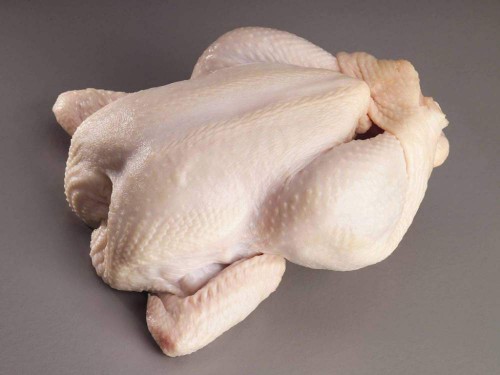
At 2 months of age the broiler reaches its maximum size
Is broiler farming a profitable business?
Breeding broilers at home is a lucrative business. They grow quickly and after two or two and a half months with your own hands you can get chickens ready for slaughter for meat. It is not recommended to keep them longer, as the growth of birds slows down and there is an overconsumption of feed.
From one broiler, you can get up to one and a half kilograms and more excellent dietary meat, which is also suitable for feeding young children, the elderly and sick people.
With minimal costs for feed and keeping at home, in a short time, you can recoup the cost of purchasing young animals, equipment, special lighting and heating and make a profit.
Chicken meat is cheaper than the same beef or pork, and is more readily purchased by both ordinary consumers and food industry enterprises.
Subscribe Be aware of new products on our site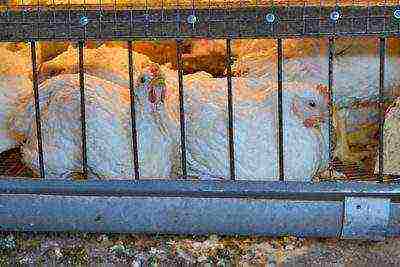
In connection with the wave of "revelations" of well-known food manufacturers, people are seriously concerned about the quality of the food they consume and what they feed their children. It is not surprising that natural, farm products are becoming more and more popular.
If you are proud of the quality of your poultry meat and are ready to deliver it to the shelves, carefully consider how you can provide the required volumes. Most often, novice farmers are very limited in the area that can be used for keeping and walking chickens.Here, the best option would be to keep chickens of meat breeds in cages.
…
Pros and cons of cellular content
 With the usual “floor” keeping of birds, it is difficult to raise a large number, especially in a small area. When there are too many birds, the struggle for food, water and space begins. First of all, chickens die, they can simply be crushed as the weakest and most vulnerable. To avoid this, they use multi-tiered constructions of cages, which contain 20-25 birds.
With the usual “floor” keeping of birds, it is difficult to raise a large number, especially in a small area. When there are too many birds, the struggle for food, water and space begins. First of all, chickens die, they can simply be crushed as the weakest and most vulnerable. To avoid this, they use multi-tiered constructions of cages, which contain 20-25 birds.
Pros:
- The ability to keep 3-5 times more chickens in the same area without harming their health.
- The increase in weight in broilers is faster, since the birds are limited in movement and all calories go to height and weight.
- The feed is consumed more efficiently, the chickens cannot scatter it and are saturated with less.
- The droppings are immediately removed from the cage, falling onto the pallet. Birds do not peck it and do not carry it into the feeder, do not become infected.
- Feeding, cleaning and daily check-ups are greatly reduced.
- Limiting contact with all livestock prevents the spread of infection.
- There is no need for bedding.
- It is easier to clean the feeders and drinkers, and the living conditions are better.
Minuses:
- the cost of buying or making cages;
- costs of additional lighting, heating and ventilation. But in the calculation for 1 head and 1 kg of weight gain, the costs are more than repaid;
- the taste of meat is lower than that of free-range birds;
- the need for daily cleaning;
- feed must be balanced, birds become sensitive to it. They do not have the ability to independently obtain a variety of supplements;
- with a large weight, chickens have problems with legs and bumps on the chest, this reduces the quality of the carcass;
- thorough disinfection is required after each batch of birds.
REFERENCE: The process of keeping chickens in cages is profitable enough to obtain large volumes of meat, but it requires some costs in the preparatory stage.
Care rules
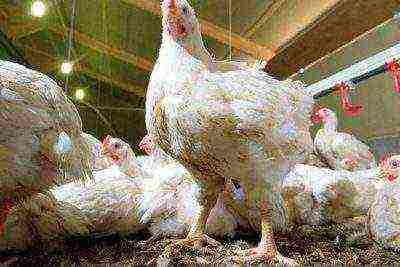 Unlike free-range chickens, caged birds have no way to move to a cooler or lighter spot. It is entirely up to the farmer to create the most comfortable conditions for the chickens. Purchase temperature and humidity sensors and carefully monitor their readings and indoor microclimate.
Unlike free-range chickens, caged birds have no way to move to a cooler or lighter spot. It is entirely up to the farmer to create the most comfortable conditions for the chickens. Purchase temperature and humidity sensors and carefully monitor their readings and indoor microclimate.
The more comfortable the conditions, the less the chickens get sick and the faster they gain weight. And the main indicator of a good microclimate is the appearance and activity of birds. Mandatory conditions that must be observed: temperature conditions, adequate lighting, an established ventilation system and an optimal level of humidity.
Let's take a closer look at these microclimate conditions:
- The humidity level must be maintained within 60-70%. With a decrease in these indicators, the birds lose their appetite, they are tormented by thirst, their appearance is disheveled. With high humidity, chickens become lethargic and sluggish, breathing heavily.
- A well-established supply and exhaust ventilation system is essential for supplying fresh air and lowering the temperature during the summer months.
- Combined lighting is used: common for the whole room and additional lighting for the smallest chickens. When adjusting the lighting, make sure that each cell receives a sufficient dose of ultraviolet radiation. Otherwise, vitamin deficiency and rickets cannot be avoided. Plus, the longer you organize daylight hours, the more your chickens eat and the faster they grow.
- When setting the temperature setting, remember that the older broilers get, the more heat they generate. Do not let them overheat, 18-20 degrees is enough for an adult bird.
- Be sure to clean up your droppings on time, among other things. It is harmful for chickens to breathe ammonia fumes, this provokes respiratory and infectious diseases. For small chickens, it is enough to clean every 5-7 days, for those that are older, once every 2-3 days, and before slaughter every day.
Zootechnical norms:
- No more than 25 birds are kept per 1m2.
- In one cage 0.5m2 10 day old chicks.
- The round feeder is designed for 40-50 birds, in the form of a trough, 2-2.5 cm long for 1 head.
- Nipple drinker for 10-12 heads, vacuum for 50 chickens, in the form of a trough, 2 cm long for 1 head.
Home breeding equipment
In the shops of poultry farms and in large industries, batteries from cages with chickens stand in 4-6 tiers. In the private sector, 2-3 tiers are quite enough. Cages or equipment for keeping broilers in them can be purchased commercially or made by hand if you have the necessary materials.
Cell structure:
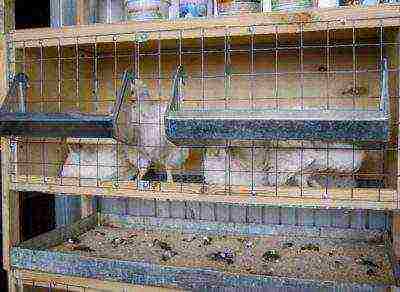 First of all, the frame is made of wooden or metal guides.
First of all, the frame is made of wooden or metal guides.- The main material of the walls and floor is mesh. It is an inexpensive and durable material that will provide the necessary ventilation and light penetration.
- Mesh bottom made of fine mesh to prevent injury to chicks. But the mesh size is large enough so that the droppings fall on the lower pallet and do not accumulate on the floor.
- The front wall is in the form of a longitudinal lattice or a net with wide meshes through which the chicken can stick its head and normally reach the feeder.
- A trough-trough is hung on the front wall of the cages for manual feeding.
- With mechanized, automatic feeding, in the center of the cage there is a feeder in the form of an inverted glass on a plate, the so-called "carousel" or "umbrella".
- Above the feeder, there is a chute or additional trays for chicks up to 20 days old to make it easier for them to reach for food.
- Lateral, transverse partitions are recommended to be mesh for better ventilation.
- Drinking troughs or vacuum, nipple type are hung on the transverse partitions. Chickens up to 10 days old are only vacuum operated so that the young do not splash water.
- A door on the front wall for catching and disembarking poultry. For meat, inspection, initial settlement.
- The pallets at the bottom should slide out easily for cleaning up droppings.
- In large poultry farms, a mechanized belt system for manure removal is used.
IMPORTANT: It is more expedient to settle the smallest chickens on the upper tier of the cages, and the largest ones below. This will give your little ones maximum light and warmth. In addition, birds of the same age get along more easily with each other.
Recommended rates for feeding, heat and lighting:
 chickens 0-5 days need lighting for 23 hours, temperature 34 degrees and 15-20 g of feed per day;
chickens 0-5 days need lighting for 23 hours, temperature 34 degrees and 15-20 g of feed per day;- at the age of 6-18 days lighting 20 hours, temperature 28 degrees, feed from 25 to 80 g per day;
- from 19 days fattening begins, lighting 18 hours, temperature 25 degrees, feed 100-150 g / day;
- closer to slaughter from the 38th week, lighting is 16-17 hours, the temperature is approaching 20 degrees, feed is 160-170 g / day.
Growing stages
Broilers are hybrids of meat breeds that are characterized by rapid growth and weight gain. When growing broilers, the main goal is to get the maximum weight gain in the shortest possible time. This approach is very different from growing oviparous breeds.
They are grown no longer than 50-70 days. With further cultivation, more than 70 days, the growth decreases, and the feed consumption increases.
It is recommended to buy chickens 10 days old, before this age the highest mortality rate. Chickens are not sexed and raised together. They are fed up to 50-70 days, the chickens grow up to 2.3-2.5 kg, after which they are slaughtered.
NOTE: Part of the livestock 20-25% is taken for early slaughter at 35 days, from the largest individuals. Free up space and exclude competition for feed and food.
A heavy bird often sits on its feet, problems with ligaments due to lack of movement, crowding, limited space, in a cage. Usually, the males are removed first, and the females after a week. Males are larger and grow faster.
There are two ways to grow:
- Seasonal, when chickens are purchased in the spring and slaughtered in the fall.
- Or year-round, when a new batch of chickens is bought every three months.
Can chickens be kept outside?
In warm weather and in good weather, it is perfectly acceptable to keep cages with chickens outside. For the convenience of transporting the batteries, the cages can be equipped with wheels from below.
Fresh air and natural light will have the most beneficial effect on productivity. And it is also the prevention of rickets in chickens, but they can be taken out into the street only from 2 weeks of age. Make sure that the birds do not overheat or, on the contrary, do not freeze.
So, for the successful maintenance of broilers in cages, it is necessary:
- maintaining a favorable microclimate in the room where the birds are kept;
- compliance with zootechnical standards;
- compliance with acceptable sanitary and hygienic conditions.
Follow these rules and your products will definitely take pride of place on the shelves among organic products!
Useful video
Watching a video about growing broilers in cages at home
